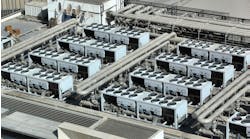Why a Transformation Toward Healthy Buildings is Necessary
Within the last three years, the number of buildings which are certified as “healthy buildings” and companies focusing on this has increased immensely. Some regions have even adopted a rating system, like the United Arab Emirates.
Although major trends such as flexibility, digitalization and automation have been influencing the design and management of buildings for a long time, the COVID-19 pandemic has fast-tracked their adoption and added a clear objective to improving the health and wellbeing of building occupants.
These days, the avoidance of “sick building syndrome”—acute health or comfort-related effects linked to time spent in a building—as well as the protection of people with allergies are key. But what exactly is a healthy building? Research highlights nine aspects: lighting, ventilation, air quality, water quality, thermal health, moisture, noise, dust and pests, safety and security. Not only does health play an essential role, but also reducing the carbon footprint of a building is a major challenge for the sector. The latest governmental regulations are adding pressure to transform buildings to become more sustainable and energy efficient. One of them is the EU’s Energy Performance of Buildings Directive (EPBD), which is also expected to make measuring indoor air quality mandatory.
Technology Solutions as Fundamental Basis
Technology solutions are manifold for the transformation towards healthy buildings, ranging from lighting, heating and cooling, and ventilation to safety and security. Three levers are of relevance:
#1: Real-time monitoring keeps track of the status quo of various building parameters, such as temperature, air quality or humidity. Trusted data sources that comply with data protection and security requirements build the basis for this. Examples include accurate Internet of Things (IoT) sensors with secure connections and access to safe, trusted cloud offerings. The sensors can be placed in rooms but also in ducts transporting air or water, and thus can give a full picture of the actual state of the parameters.
#2: Real-time operational technology (OT) data should be enriched with third-party data, such as weather forecasts. Different kinds of usage patterns can be tracked depending on days or seasons.
#3: Artificial Intelligence (AI) algorithms can learn from the patterns of each building and create the most efficient solution tailored to the individual usage profile. IoT automation and AI-based cloud applications help to connect, digitize and optimize building management solutions, offering a modular approach that makes building automation functionality accessible to more people. Connectivity enables an integration with various sensors and actuators used in the building, utilizing an open and scalable ecosystem approach.
In general, building operators need to strike the right balance between AI-optimized building automation and individual people’s needs—e.g., blinds might lower automatically when the sun comes out, yet some might love to see a bit of sunshine. Thus, when implementing AI, it is vital to adopt a human-centric approach. People using and operating buildings need to feel confident about the space’s condition and functionality in use. Transparency about the status of its parameters is crucial to harness their potential.
Outlook
The transformation towards healthy buildings becomes increasingly important. Buildings not only shape our urban landscapes. We spend 90% of our lives indoors, so building health and well-being really matters. Additionally, healthy buildings can be considered a win-win situation as they use energy more sustainably while promoting productivity. Ultimately, they are also a competitive advantage for building owners and operators as buildings in which people feel well and safe are easier to rent out and bring better earnings.


